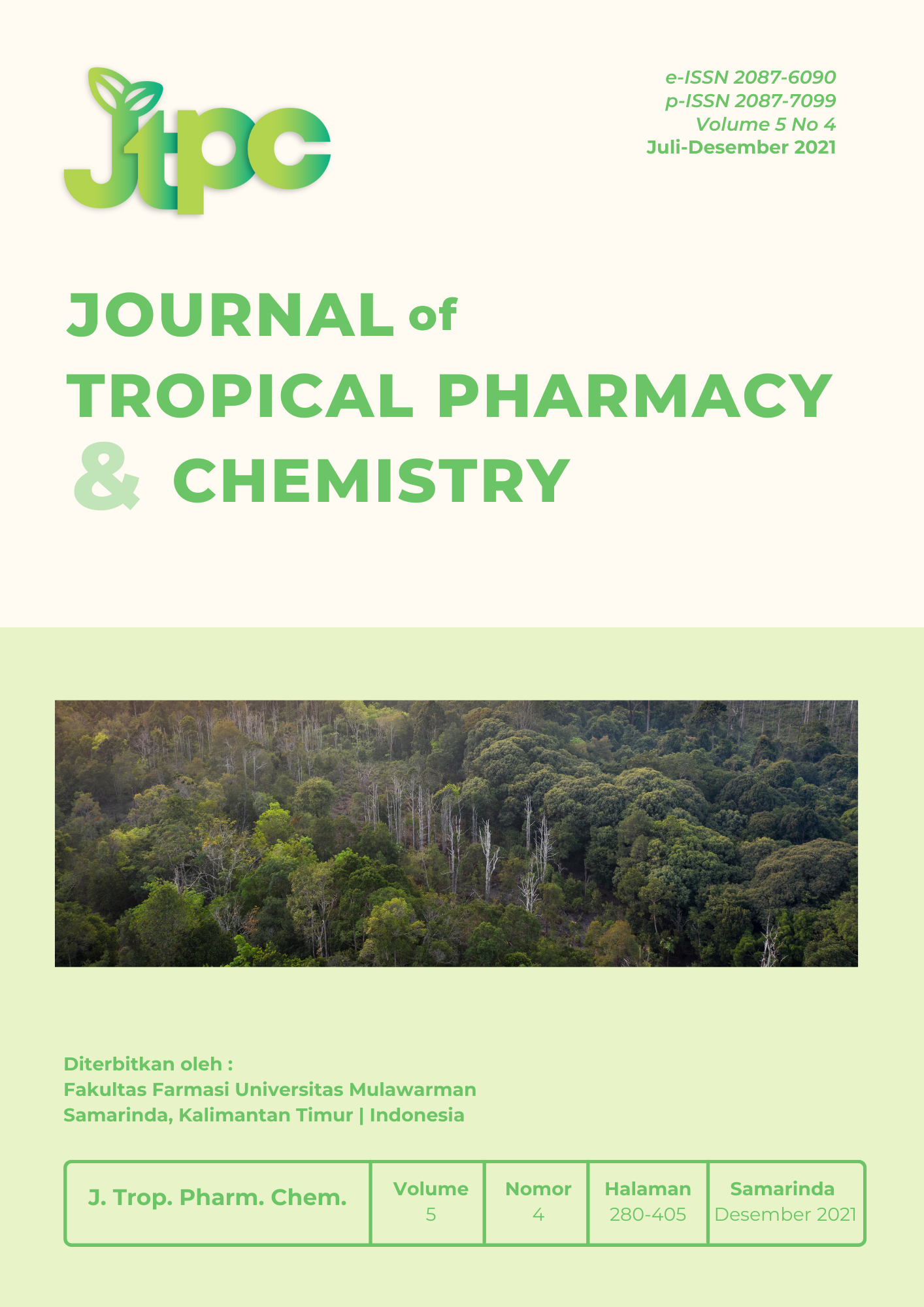Identification and Determination of Berberine from Arcangelisia Flava, East Borneo
DOI:
https://doi.org/10.30872/j.trop.pharm.chem.v5i4.263Keywords:
Berberine, TLC, HPLC, Arcangelica FlavaAbstract
Berberine is a compound that has various benefits but also has dangerous toxic effects. In Indonesia, the Regulation of the Head of the Food and Drug Supervisory Agency No. 10 of 2014 concerning the Prohibition of Producing and Circulating Traditional Medicines and Health Supplements Containing Coptis Sp, Berberis Sp, Mahonia Sp, Chelidonium Majus, Phellodendron Sp, Arcangelica Flava, Tinosporae Radix, and Catharanthus Roseus. Regulation No. 7 of 2018 (BPOM, 2018) also prohibits the presence of berberine in processed food. This research was conducted to determine the content of berberine compounds from the extract and stem fraction of Arcangelisia flava. The research was conducted by identifying the content of berberine by TLC method compared with Rf Berberine sulfate and determination of berberine content by HPLC method (High-Performance Liquid Chromatography) using column C-18 (ODS). Berberine content of methanol extract, n-hexane fraction, ethyl acetate fraction and Arcangelisia Flava methanol-water fraction were 0.0040, respectively; 0.0010; 0.0041, 0.0044%.
Downloads
References
[1] B. P. O. dan M. BPOM, ‘Peraturan Kepala Badan Pengawas Obat Dan Makanan Republik Indonesia Nomor 10 Tahun 2014 Tentang Larangan Memproduksi Dan Mengedarkan Obat Tradisional Dan Suplemen Kesehatan yang Mengandung Coptis Sp, Berberis Sp, Mahonia Sp, Chelidonium Majus, Phellodendron Sp, Arcangelica Flava, Tinosporae Radix, dan Cataranthus Roseus’, BPOM RI, 2014. [Online]. Available: https://asrot.pom.go.id
[2] Vikas. Chander, J. R. Aswal, R. Dobhal, and D. P. Uniyal, ‘A review on Pharmacological potential of Berberine?; an active component of Himalayan Berberis aristata’, J. Phytopharm., vol. 6, no. 1, pp. 53–58, 2017, [Online]. Available: https://www.researchgate.net/publication/343569264_A_review_on_Pharmacological_potential_of_Berberine_an_active_component_of_Himalayan_Berberis_aristata
[3] E. Hayati, A. R, A. Nihayatul, A. Madjid, and R. Mutiah, ‘The Separation Optimization of Berberine in Anting-Anting Plants (Acalypha Indica Linn) using High Performance Liquid Chromatography (HPLC)’, J. Phys. Conf. Ser., vol. 1375, p. 012021, Nov. 2019, doi: 10.1088/1742-6596/1375/1/012021.
[4] M. L. Simões et al., ‘The Anopheles FBN9 immune factor mediates Plasmodium species-specific defense through transgenic fat body expression’, Dev. Comp. Immunol., pp. 1–9, 2016, doi: 10.1016/j.dci.2016.09.012.
[5] N. C. for B. I. NCBI, ‘PubChem Compound Summary for CID 2353, Berberine’, 2020. https://pubchem.ncbi.nlm.nih.gov/compound/Berberine. (accessed Nov. 01, 2020).
[6] S. Mehrzadi, I. Fatemi, M. Esmaeilizadeh, H. Ghaznavi, H. Kalantar, and M. Goudarzi, ‘Hepatoprotective effect of berberine against methotrexate induced liver toxicity in rats’, Biomed. Pharmacother., vol. 97, pp. 233–239, Jan. 2018, doi: 10.1016/j.biopha.2017.10.113.
[7] K. Rajasekhar, S. Samanta, V. Bagoband, N. A. Murugan, and T. Govindaraju, ‘Antioxidant Berberine-Derivative Inhibits Multifaceted Amyloid Toxicity’, iScience, vol. 23, no. 4, p. 101005, Apr. 2020, doi: 10.1016/j.isci.2020.101005.
[8] S. A. Javad-Mousavi et al., ‘Protective effect of Berberis vulgaris fruit extract against Paraquat-induced pulmonary fibrosis in rats’, Biomed. Pharmacother., vol. 81, pp. 329–336, Jul. 2016, doi: 10.1016/j.biopha.2016.04.027.
[9] E. Dwi et al., ‘Bioenergetics Biochemical studies of membrane bound Plasmodium falciparum mitochondrial L -malate?: quinone oxidoreductase , a potential drug target’, BBA - Bioenerg., vol. 1859, no. 3, pp. 191–200, 2018, doi: 10.1016/j.bbabio.2017.12.004.
[10] X. Xu et al., ‘Antidiabetic Effects of Gegen Qinlian Decoction via the Gut Microbiota Are Attributable to Its Key Ingredient Berberine’, Genomics Proteomics Bioinformatics, vol. 18, no. 6, pp. 721–736, Dec. 2020, doi: 10.1016/j.gpb.2019.09.007.
[11] Y. Gao, F. Wang, Y. Song, and H. Liu, ‘The status of and trends in the pharmacology of berberine: a bibliometric review [1985–2018]’, Chin. Med., vol. 15, no. 1, p. 7, Jan. 2020, doi: 10.1186/s13020-020-0288-z.
[12] Y. Dou et al., ‘Oxyberberine, an absorbed metabolite of berberine, possess superior hypoglycemic effect via regulating the PI3K/Akt and Nrf2 signaling pathways’, Biomed. Pharmacother., vol. 137, p. 111312, May 2021, doi: 10.1016/j.biopha.2021.111312.
[13] N. Sriwilaijareon, S. Petmitr, and A. Mutirangura, ‘Stage specificity of Plasmodium falciparum telomerase and its inhibition by berberine’, Parasitol. Int., vol. 51, no. 1, pp. 99–103, 2002, doi: 10.1016/S1383-5769(01)00092-7.
[14] B. P. O. dan M. BPOM, ‘Larangan Memproduksi dan Mengedarkan Obat Tradisional Dan Suplemen Kesehatan yang Mengandung Coptis Sp, Berberis Sp, Mahonia Sp, Chelidonium Majus, Phellodendron Sp, Arcangelica Flava, Tinosporae Radix, dan Cataranthus Roseus’, Kementerian Kesehatan RI, Jakarta Indonesia, E-Reporting Obat Tradisional, Suplemen Makanan dan Kosmetik Peraturan Kepala Badan POM No. 10 Tahun 2014, 2015.
[15] K. Niwat, S. Dej-adisai, and S. Yuenyongsawad, ‘Antioxidant and cytotoxic activities of Thai medicinal plants named Khaminkhruea: Arcangelisia flava, Coscinium blumeanum and Fibraurea tinctoria’, Songklanakarin J. Sci. Technol., vol. 27, Aug. 2005.
[16] B. P. O. dan M. BPOM, ‘Peraturan Badan Pengawas Obat dan Makanan Nomor 7 Tahun 2018 tentang Bahan Baku yang dilarang dalam Pangan Olahan’, Kementerian Kesehatan RI, Jakarta Indonesia, 2018.
[17] R. Singh and B. Sharma, ‘Therapeutic Potential of Plant Based Natural Compounds for Malaria - Recent Advances and Future Perspective’, EC PHARMACOLOGY AND TOXICOLOGY, vol. 7, pp. 1078–1089, Sep. 2019.
[18] E. Küpeli, M. Ko?ar, E. Ye?ilada, and K. H. C. Ba?er, ‘A comparative study on the anti-inflammatory, antinociceptive and antipyretic effects of isoquinoline alkaloids from the roots of Turkish Berberis species’, Life Sci., vol. 72, no. 6, pp. 645–657, Dec. 2002, doi: 10.1016/S0024-3205(02)02200-2.
[19] E. Ye?ilada and E. Küpeli, ‘Berberis crataegina DC. root exhibits potent anti-inflammatory, analgesic and febrifuge effects in mice and rats’, J. Ethnopharmacol., vol. 79, no. 2, pp. 237–248, Feb. 2002, doi: 10.1016/S0378-8741(01)00387-7.
[20] C. E. Ho, Y. L. Goh, and C. Zhang, ‘From Prejudice to Evidence: The Case of Rhizoma Coptidis in Singapore’, Evid. Based Complement. Alternat. Med., vol. 2014, p. 871720, Dec. 2014, doi: 10.1155/2014/871720.
[21] M. Mahmoudi et al., ‘Immunotoxicity induced in mice by subacute exposure to berberine’, J. Immunotoxicol., vol. 13, no. 2, pp. 255–262, Mar. 2016, doi: 10.3109/1547691X.2015.1058306.




